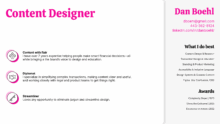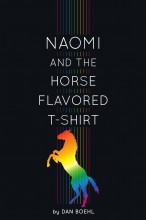Dear Reader,
I’ve decided to undertake an ambitious self-publishing and fundraising experiment by releasing my new novel-in-progress serially for free, while asking readers to donate to me using a pay-what-you-want model along with a Kickstarter-like incentive program. I’ll be writing posts about why I decided to undertake this serial/crowdsourcing experiment and my reasoning and calculations behind it.
Last year I self-published my middle grade novel, Naomi and the Horse-Flavored T-Shirt, on the Amazon Kindle and through some print on demand services. All told I spent about $7,000 on this project. My goals were to build a larger audience for my work, to make back the money I put into the project, and to sell out my book of poetry Kings of the Fucking Sea.

To create Naomi I hired a professional free-lance editor, a young adult fiction marketing consultant, and a designer using money I received in two insurance settlements where drivers hit me with their cars while I was biking to different grocery stores (The year before had been rough, as I also got divorced.)
Hiring these people turned out to be expensive considering that a little less than a year later I have seen very little returns on my investment. But hiring these people and learning about book marketing and promotion, along with my work at Birds, LLC, has provided me with an invaluable education in publishing and marketing.
After the release of Naomi I began to research the self-publishing and promotion market like crazy. One thing that I learned was that genre fiction sells (or is downloaded for free) really well. Readers eat it up. The problem, then, with Naomi was that I was selling it at a reasonable rate ($2.99 on e-readers) and that it is a middle grade novel. Being a middle grade novel the audience (tweens) is protected by all the publishing gatekeepers (parents, teachers, reviewers, agents, publishers). Self-publishing on the Internet is all about circumventing gatekeepers and I had waded into gatekeeper central.
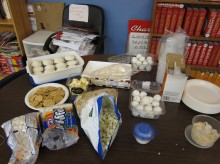
So, Naomi isn’t selling because it is hard to get the word out about a book for middle school kids when there is no direct way for me to reach them. And, what I discovered is that middle school readers really respond to the book when given a chance to read it.
A colleague of mine is a middle school teacher who gave her students the option to read Naomi for class. These students read it and loved it. I went to their classroom and did a reading, and it was the best experience of my writing career, even better than all of the poetry readings I have done in the past. And these kids knew their stuff, grilling me about tons of post-apocalyptic literature. They brought in white foods to simulate paste from the book, and on the way into the school, one student stopped me and said, “You’re Dan Boehl. I read your book.” The whole experience ruled so hard.
Anyway, my experiences with Naomi and the articles I have been reading over the past year convinced me to try a different self-publishing strategy: self-publish my new book, a romantic fantasy about drug-dealing witches in rural Pennsylvania, in serial form on Amazon, Smashwords, on torrent sites, and on my website, all for free, as I write it.
Later I got the idea to do a Kickstarter-like donation campaign along with the release of the book sections. This is really what I want to talk about in theses posts. My research, inspiration, and work on the crowdsourcing experiment.
Serial Release Experiment
The Guardian does an amazing job covering publishing, self-publishing, and the effects these things have on the publishing business. It’s no surprise that Cory Doctorow, who has taught me a lot of what I’ve learned about self-publishing, writes for them. Check out the Guardian if you want to learn the ins and outs of self-publishing, pirating, and marketing books.

I wrote about one article I read at the Guardian here. In it, Ewan Morrison talks about “long-tail” sales and how Amazon does not care about promoting self-publishers because no matter what Amazon will make money off of their work and through Kindle sales. I won’t go into the details. Just go read the article.
Anyway, this, along the Smashwords Book Marketing Guide by Mark Coker, the founder of Smashwords (it is interesting to note that this book is the #2 downloaded book on Smashwords, right behind his other book on formatting eBooks) got me thinking about giving a book away for free in order to build an audience for what is my second novel, the Fire Twins. Coker also talks about adding teasers and links to author websites at the end of eBooks, two elements which are the crux of my crowdsourcing campaign.
Each section of the Fire Twins is about one hundred pages long and each is told from the point of view of a different witch (Tommy, Ingrid, Adelaide, Cotton, Kathleen). Two of the five sections of the book are already completed. So, I figured if I released each section for free over the course of a year or year and a half on my website and as many other outlets as possible I would be able to build an audience interested in the Fire Twins and the rest of my work.
When I started writing fiction ten years ago I would write at least 400 words each day. I would email what I wrote to my friend and fellow writer Cordelia Jensen. Cordelia read all of Naomi and the Horse-Flavored T-Shirt as I wrote it, day after day, four or five hundred words at a time (the only comments she was allowed to give were things she liked, you know, as motivation).
I like working this way. The serial nature of the writing keeps me writing and keeps me focused on my audience.
By releasing The Fire Twins serially and seeing an audience grow as the book comes out I hope to build a conversation about the work as its created.
Also, check out that cover. Carlos Rosales-Silva made it.
Goals of the Serial Release/Crowdsourcing Experiment
In the summer of 2011 I attended the Creative Capital Professional Development Program held at Arthouse in Austin. The program teaches artists business strategies that further their careers and make it possible to support themselves through their art. This was an amazing workshop, and if you are an artist or writer who has one of these come to your town I recommend you apply. It teaches you to approach your art like a business while not compromising your work.
 The Creative Capital workshop stresses goal setting, so I am going to talk about my goals for the Serial Release/Crowdsourcing Experiment.
The Creative Capital workshop stresses goal setting, so I am going to talk about my goals for the Serial Release/Crowdsourcing Experiment.
At first this experiment started out as simply a serial release experiment.
- Complete the Fire Twins.
- Build an audience for the Fire Twins.
The first goal is easy to achieve. I will finish writing the Fire Twins just as I completed writing Naomi and the Horse-Flavored T-Shirt, Kings of the F**king Sea, and two poetry manuscripts I am now editing and sending out for publication.
The second goal is much harder. In order to build an audience for the Fire Twins I have to get it in the hands of readers. Lots of readers. Giving it away for free helps, and because of my work publishing poetry and Naomi I have a very firm grasp on how to market the book and tell the right people about it. Of course, to get an audience the book has to be good. I will let you, dear reader, judge that for yourself.
But there is an unstated third goal that every writer has:
- Get paid.
When I say “get paid” I don’t mean making millions of dollars and living solely on book sales. I mean generating some kind of income on sales so the effort can pay a little back to the author.
 Writing, and especially editing, involves thousands of hours of toil that is done, in the end, for the love of writing. As a poet (NB: it’s impossible to sell out as a poet. Yes, even Billy Collins isn’t a sellout.) I know all too keenly that there is a very small market for my writing but that market is made up of a very generous audience of readers and fellow writers.
Writing, and especially editing, involves thousands of hours of toil that is done, in the end, for the love of writing. As a poet (NB: it’s impossible to sell out as a poet. Yes, even Billy Collins isn’t a sellout.) I know all too keenly that there is a very small market for my writing but that market is made up of a very generous audience of readers and fellow writers.
Any writer who sets out writing to get rich, especially in today’s market, should read Tim Park’s article in the New York Review of Books and this Ursula K. Le Guin interview from the Atlantic.
I’d like to get rich writing, but I’m probably not gonna, so I just want to raise $35,000 so I can take time off work to finish writing and editing the Fire Twins and ready the book for publication. Maybe by the time the book is complete a publisher will want it. (Don’t fret, co-workers. I am going to keep my job when all this is done ((I actually like my job, a fact I consider to be a major blessing.))).
To reach my third goal I decided to tack on a Kickstarter-like pay-what-you-want incentive program to the serial release experiment.

Kickstarter
I am sure by now you have heard of Kickstarter or backed a project there. It seems to be revolutionizing the way creative (and technology) projects are funded.
 The first project I ever backed on Kickstarter belonged to my friend Jules Buck Jones, an artist who created a full-color hardback book Everglades. When Jules launched his Kickstarter campaign more than two years ago, Kickstarter was pretty new, but by having a great video and using his social media connections and his collector base (audience) he was able to meet his goal on time and put out an awesome book.
The first project I ever backed on Kickstarter belonged to my friend Jules Buck Jones, an artist who created a full-color hardback book Everglades. When Jules launched his Kickstarter campaign more than two years ago, Kickstarter was pretty new, but by having a great video and using his social media connections and his collector base (audience) he was able to meet his goal on time and put out an awesome book.
Just recently, another one of my friends, Matt Rebholz, launched a Kickstarter campaign to raise $4000 to attend the Vermont Studio Center and work on his comic book, the Astronomer. His campaign raised over $11,000!
Matt’s campaign did so well because he has a dedicated social network of friends and collectors (an audience) willing to fund his work, work that is amazing and deserves financial support, but also because his audience was willing to recommend his work and campaign to their friends. Matt’s dedicated audience helped him spread the word about his work and his campaign.
 I think this is the way the Internet and social media networks are empowering audiences. Same with writers. eBooks are changing the way books are marketed and disseminated, but that alone does not help writers (go back and look at Amazon’s long-tail scheme: they don’t really care about individual writers).
I think this is the way the Internet and social media networks are empowering audiences. Same with writers. eBooks are changing the way books are marketed and disseminated, but that alone does not help writers (go back and look at Amazon’s long-tail scheme: they don’t really care about individual writers).
What helps writers is that they can interact directly with their audience. Because I am a publisher (Birds, LLC) and a poet, I interact directly with my poetry audience on Facebook on a daily basis. It just so happens that my audience is made up of publishers and poets, and they interact with me as a member of their audience (most poetry readers write poetry, so poetry has a reciprocal, gift economy. You can read what my friend and business partner, Sampson Starkweather, has to say about that here.)
Okay: Matt’s success with Kickstarter got me thinking: why not experiment with a donation (sort of a pay-what-you-want) model to see if this new audience I am trying to find for the Fire Twins would be willing to fund the completion of the book. In return I’d offer incentives like on Kickstarter and NPR fund drives. Other artists are trying to monetize in similar ways. Reuben Bolling of Tom the Dancing Bug has a subscription service he calls the Inner Hive. He doesn’t know if this model is going to work, but he is experimenting. I’m a subscriber.
So, why not Kickstarter?
Dan, why aren’t you using Kickstarter for your Serial Release/Crowdsourcing Experiment, you may ask. There are a few simple reasons:
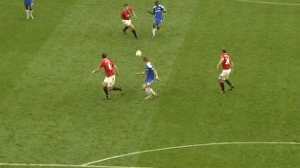 Kickstarter places a time limit on crowdsourcing campaigns. The nature of my Serial Release/Crowdsourcing Campaign is to build a dedicated audience over a long period of time. It will probably take a year and a half to get the Fire Twins written, edited, and ready for publication, and the time limit on Kickstarter projects is incompatible with my goals at this time.
Kickstarter places a time limit on crowdsourcing campaigns. The nature of my Serial Release/Crowdsourcing Campaign is to build a dedicated audience over a long period of time. It will probably take a year and a half to get the Fire Twins written, edited, and ready for publication, and the time limit on Kickstarter projects is incompatible with my goals at this time.
- I am trying to raise $35,000, and I just don’t think I have a wide enough audience to support this kind of goal at this time.
- Kickstarter works on an all-or-nothing model. If a project does not reach its full fundraising goal then the artist does not receive any of the funding. This model would be okay if I were undertaking a less ambitious project with a smaller fundraising goal, but at this time and for the amount of support I am seeking, this just won’t work for me.
- All my content is available from my website, so I want people going to my website and seeing all the stuff I write and do, and by that method I may increase my audience and market for my work.
If you are interested, you can take a look at the Kickstarter programs I have backed in the past.
I studied the Kickstarter projects of Amanda Palmer, Seth Godin, and Ryan Koo. Koo wrote a long article on how he ran a $125,000 campaign to fund a film project. I used Koo’s article to do many of the calculations that went into my Serial Release/Crowdsourcing Experiment.
Donation Calculations
The first order of business was to figure out how much money I would need to raise so I could take off work for six months to focus solely on writing and editing. Here is my first calculation sheet:
You’ll see at the top I figured out the expenses for my incentive (premium) levels. I’ll come back to that. For now I’ll focus on the calculations that went into the “Living Expenses” category. (NB: These are rough estimates. I am not an accountant and I probably screwed up the math somewhere.)
Health Care:
I get sick every so often and every so often a doctor or student will hit me with their car as I ride my bike to the grocery store. So, even though I want to take time off work, I still want health care (I also carry short- and long-term disability and have a life insurance plan. I need them in case one day a doctor or student really smashes me good). So the first calculation is an estimate of what six months health care would cost me through The University of Texas health care program. I figured I’d need $350 a month times 6 months. $2100.
Salary:
This is roughly half my yearly salary: $22,000. I think that one speaks for itself.
Income tax:
I subtracted the yearly federal income tax from my total: $1642.41. I just looked at my paycheck for a month and multiplied this by six. Maybe I should not have subtracted this from my living expenses because I’ll have to pay income tax on the donation money, but whatever. I subtracted it.
Social Security Tax:
Figured the same way as income tax: $832.76. Again, I may pay this out of the donation money. Dunno yet. I’m not an accountant. I hope Social Security will still be around by the time I am old enough to collect it. I am not holding my breath on that one.
Medicare:
$287.51. See the Income and Social Security explanations.
Total Income Needed:
This is the Health Care total plus the Salary totally. $24,000, rounded down to the nearest thousand.
Total Deductions:
You got it. It’s all those taxes added up. No rounding.
Total Income:
I figured I would need $21,237.32 to live on for six months.
So, if that is what I need to live on for six months, why is my crowdsourcing goal $35,000? Well, that has to do with the Donation Premium Calculations listed at the top of the page.

Donation and Incentive Levels
My girlfriend, Tory Gibler, and I both work in fundraising: me for the University of Texas, her for the cancer survivor advocacy foundation, Livestrong. She has a lot of experience in annual giving (think NPR fund drives) so she helped me come up with donation and incentive levels for my experiment.
 The first thing we did was look at the successful Kickstarter campaigns that I have backed in the past. We focused mostly on Matt Rebholz’s the Astronomer campaign because it was so successful and exceeded its goal. I also looked at the Amanda Palmer campaign and read a ton of articles about it. Her campaign is where I got the idea for the $5000 level. (Her fans pooled money for her higher-level donations and she will give them private performances. I can only dream that I would have readers that would do this for me, but I am a dreamer.)
The first thing we did was look at the successful Kickstarter campaigns that I have backed in the past. We focused mostly on Matt Rebholz’s the Astronomer campaign because it was so successful and exceeded its goal. I also looked at the Amanda Palmer campaign and read a ton of articles about it. Her campaign is where I got the idea for the $5000 level. (Her fans pooled money for her higher-level donations and she will give them private performances. I can only dream that I would have readers that would do this for me, but I am a dreamer.)
But most of Tory’s and my attention focused on the article by Ryan Koo concerning his $125,000 Kickstarter project. He says that most donations come in at the $50 level. Tory and I found an article that crunched a bunch of campaigns and said that most donations come in at the $25 level. For the life of me I cannot find this article. Somewhere, too, I found percentages for the donation levels that said:
5% of donations come in at the $5 level.
13% of donations come in at the $10 level.
26% of donations come in at the $25 level.
17% of donations come in at the $50 level.
11% of donations come in at the $100 level.
I can’t find that article either, but I used the percentages when I did my calculations, as you can see on the worksheet in the next section.
Next, Tory and I figured out what donors should receive for each level, keeping in mind that we wanted to offer things that would make people want to upgrade their donation. For example, if a donor wanted to give $25 towards the effort of writing the Fire Twins, we wanted the $50 level to be so appealing that the donor would upgrade their donation.
Once we figured out what the premiums would be, I calculated how much each premium would cost me to create and ship. You can see those numbers on the worksheet, and later I amended them by adding a finished print copy of the Fire Twins to some levels, which you can see in red ink.
Next I had to figure out how many gifts at which levels I could expect if I were to meet my goal, and how much this would all cost in production.
Premium Expenses Worksheet
This is the Premium Expenses Worksheet.
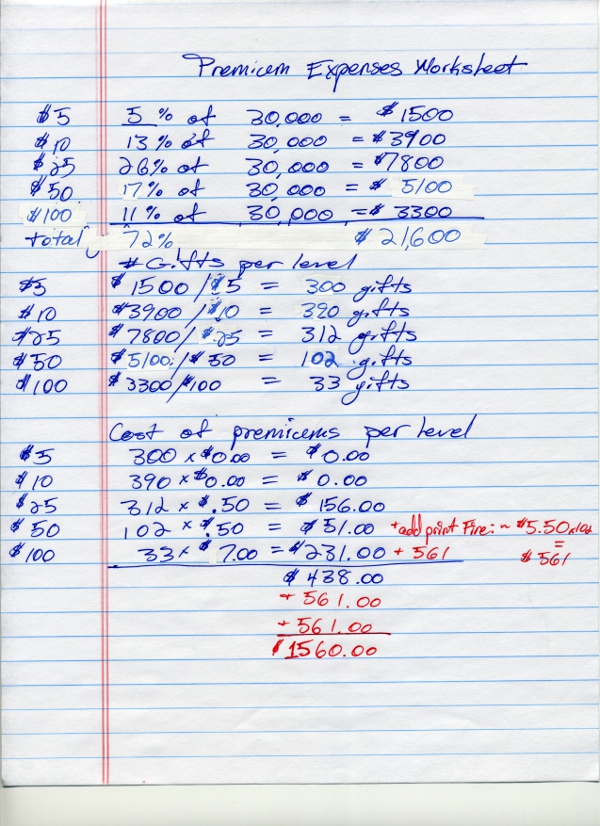
You will notice that the calculations are made with a goal of $30,000. I increased my goal later when I added a finished copy of the Fire Twins to the higher donation categories. I have a revised worksheet for that, but first I’ll show you how I did my calculations.
I took the estimated percentages of donations made for each donation level and figured out how much money I should be raising at each donation level. So, using my original goal of $30k I did the algebra and figured out that I would need to make $1500 at the $5 level.
In the next set of calculations I figured out how many gifts these amounts would translate to. So, if I’m going to raise $1500 at the $5 level, this would mean that I can expect 300 gifts at this level. By carrying this calculation all the way down I figured that to reach my goal with these donation categories means that I would receive approximately 1137 gifts at these levels.
NB: As noted on the first set of calculations, this only accounts for 72% of the total gifts, the rest of the goal being made up of the higher level gifts, which, as you can calculate, one $5000 gift would account for 16% of the total goal. These big amounts would likely come in from what the Kickstarter world is calling “angel investors.” Since I can’t really count on having some “angel investors,” I left these levels out of the calculations.
In the calculations I figured that I would get 1137 gifts at these levels. In the revised worksheet this total came out to be 1172 gifts
Next you will see my calculations for how much each premium will cost me at each level. This number, later revised with the addition of the Fire Twins print copy, gets put into my goal totals.
How Many Readers/Donors Need to Visit My Website
Figuring out how many people actually have to see my crowdsourcing appeal is the most sobering aspect of my Serial Release/Crowdsourcing Experiment.
In Ryan Koo’s article about his campaign he says that he figured he would need to get 200,000 people to see his campaign, and 1% would make a donation. This is consistent with numbers I’ve heard about retail web sales. 1% of people who see some kind of appeal will make a contribution. In philanthropic appeals this number is higher, like 3-6%, but I don’t have a source on that. So, take these numbers with a grain of salt.
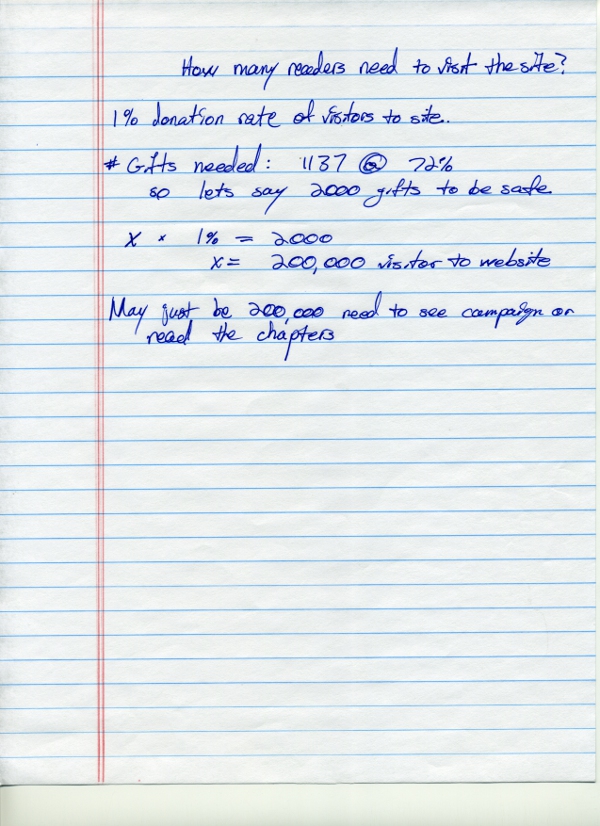 You will see on this worksheet that I calculated that I would need to get 2000 gifts to make my goal, which is 1% of 200,000. So, I need 200,000 readers and interested parties for the Fire Twins.
You will see on this worksheet that I calculated that I would need to get 2000 gifts to make my goal, which is 1% of 200,000. So, I need 200,000 readers and interested parties for the Fire Twins.
Here is the same total again on the revised worksheet.
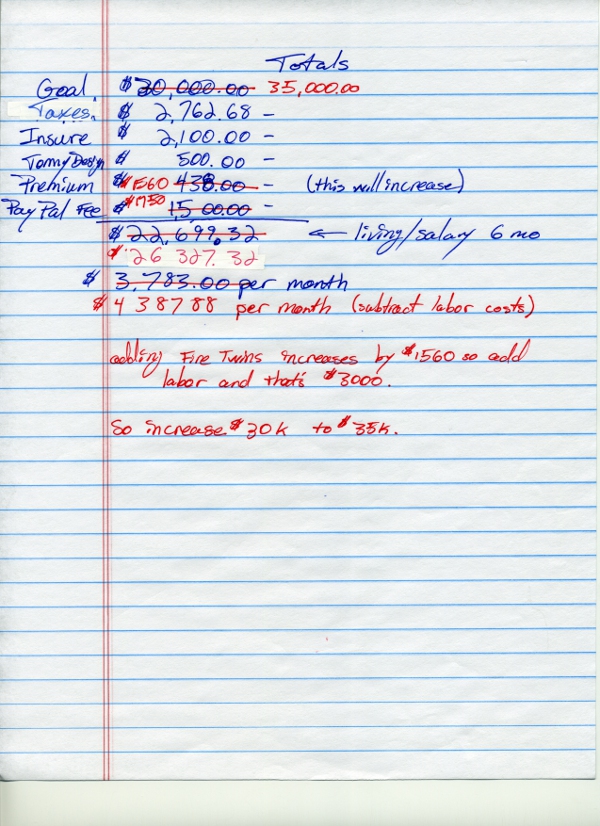
200,000 readers/visitors/people/whathaveyous is a huge amount of people. I am likely setting myself up for failure.
But I figure that more and more people will see my webpage as I continue to release the Fire Twins sections over the next year to year and a half.
Oh man. More about that next.
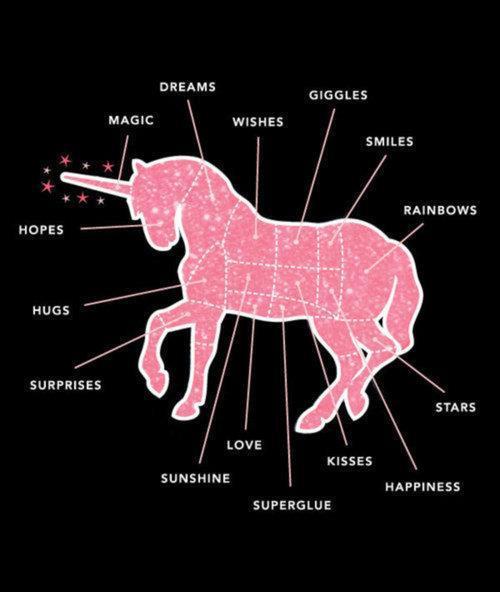
Marketing and next steps
 So, I am confronted with the problem of getting 200,000 people to see my webpage and crowdsourcing appeal. This is a bananas amount of people. So, how am I going to do it?
So, I am confronted with the problem of getting 200,000 people to see my webpage and crowdsourcing appeal. This is a bananas amount of people. So, how am I going to do it?
- Release the Fire Twins for free on Amazon, Smashwords, Issuu, and my website. (The first chapter is not yet free on Amazon. I am working on this, but they do not want self-publishers giving books away for free. I have read this is a quality control, which really makes no sense because people are uploading gobbledygook with titles similar to popular books and ripping people off, as explained in this On the Media podcast from NPR. But self-publishers who are trying to take advantage of Amazon’s audience are not allowed to manage content the way they want. This seems counter intuitive because Amazon really wants to sell Kindles, not so much books.)
- Upload the Fire Twins to torrent sites.
- Inside each chapter include two appeals asking for a donation and a link back to my website donation page.
- Use email, Facebook, and Twitter to announce my plans and ask my friends and readers to share the Fire Twins with people they think would like the book.
- Write a lengthy explanation documenting my research and source materials and release this explanation one section at a time as blog posts.
- Individually email fantasy bloggers asking them to read the Fire Twins.
- Hope and worry. Probably give myself an ulcer.
- Listen to advice from Seth Godin.
- Continue writing the Fire Twins and have a finished draft in one year’s time. Edit the hell out of it and make it the best book it can possibly be.
Thanks for reading this long explanation. If you like romantic fantasy books about witches, vampires, ghosts, drugs, and murder, please download the Fire Twins sections and sign up for my email list so I can let you know when I release the new sections.
Love,
Dan


